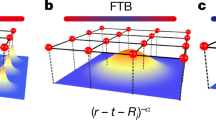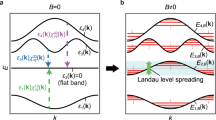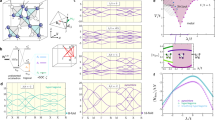Abstract
Exotic phases of matter can emerge from the interplay between strong electron interactions and non-trivial topology. Materials that have non-dispersing bands in their electronic band structure, such as twisted bilayer graphene, are prime candidates for strongly interacting physics. However, existing theoretical models for obtaining these ‘flat bands’ in crystals are often too restrictive for experimental realizations. Here we present a generic theoretical technique for constructing perfectly flat bands from bipartite crystalline lattices. Our prescription encapsulates and generalizes the various flat-band models in the literature and is applicable to systems with any orbital content, with or without spin–orbit coupling. Using topological quantum chemistry, we build a complete topological classification in terms of symmetry eigenvalues of all the gapped and gapless flat bands. We also derive criteria for the existence of symmetry-protected band touching points between the flat and dispersive bands, and identify the gapped flat bands as prime candidates for fragile topological phases. Finally, we show that the set of all perfectly flat bands is finitely generated and construct the corresponding bases for all 1,651 Shubnikov space groups.
This is a preview of subscription content, access via your institution
Access options
Access Nature and 54 other Nature Portfolio journals
Get Nature+, our best-value online-access subscription
$29.99 / 30 days
cancel any time
Subscribe to this journal
Receive 12 print issues and online access
$209.00 per year
only $17.42 per issue
Buy this article
- Purchase on Springer Link
- Instant access to full article PDF
Prices may be subject to local taxes which are calculated during checkout

Similar content being viewed by others
Data availability
All data related to this paper are available in the Supplementary Information.
Code availability
The code necessary to generate the flat-band bases can be made available upon request from the authors.
References
Bistritzer, R. & MacDonald, A. H. Moiré bands in twisted double-layer graphene. Proc. Natl Acad. Sci. USA 108, 12233–12237 (2011).
Cao, Y. et al. Correlated insulator behaviour at half-filling in magic-angle graphene superlattices. Nature 556, 80–84 (2018).
Cao, Y. et al. Unconventional superconductivity in magic-angle graphene superlattices. Nature 556, 43–50 (2018).
Po, H. C., Zou, L., Vishwanath, A. & Senthil, T. Origin of mott insulating behavior and superconductivity in twisted bilayer graphene. Phys. Rev. X 8, 031089 (2018).
Po, H. C., Zou, L., Senthil, T. & Vishwanath, A. Faithful tight-binding models and fragile topology of magic-angle bilayer graphene. Phys. Rev. B 99, 195455 (2019).
Song, Z. et al. All magic angles in twisted bilayer graphene are topological. Phys. Rev. Lett. 123, 036401 (2019).
Xie, F., Song, Z., Lian, B. & Bernevig, B. A. Topology-bounded superfluid weight in twisted bilayer graphene. Phys. Rev. Lett. 124, 167002 (2020).
Mielke, A. Ferromagnetic ground states for the Hubbard model on line graphs. J. Phys. A 24, L73–L77 (1991).
Mielke, A. & Tasaki, H. Ferromagnetism in the Hubbard model. Commun. Math. Phys. 158, 341–371 (1993).
Wu, C., Bergman, D., Balents, L. & Das Sarma, S. Flat bands and Wigner crystallization in the honeycomb optical lattice. Phys. Rev. Lett. 99, 070401 (2007).
Huber, S. D. & Altman, E. Bose condensation in flat bands. Phys. Rev. B 82, 184502 (2010).
Goda, M., Nishino, S. & Matsuda, H. Inverse Anderson transition caused by flatbands. Phys. Rev. Lett. 96, 126401 (2006).
Chalker, J. T., Pickles, T. S. & Shukla, P. Anderson localization in tight-binding models with flat bands. Phys. Rev. B 82, 104209 (2010).
Mielke, A. Ferromagnetism in the Hubbard model on line graphs and further considerations. J. Phys. A 24, 3311–3321 (1991).
Mielke, A. Exact ground states for the Hubbard model on the Kagome lattice. J. Phys. A 25, 4335–4345 (1992).
Mielke, A. Exact results for the U = infinity Hubbard model. J. Phys. A 25, 6507–6515 (1992).
Huda, M. N., Kezilebieke, S. & Liljeroth, P. Designer flat bands in quasi-one-dimensional atomic lattices. Phys. Rev. Res. 2, 043426 (2020).
Liu, H. et al. Observation of flat bands due to band hybridization in the 3d-electron heavy-fermion compound CaCu3Ru4O12. Phys. Rev. B 102, 035111 (2020).
Meier, W. R. et al. Flat bands in the CoSn-type compounds. Phys. Rev. B 102, 075148 (2020).
Baboux, F. et al. Bosonic condensation and disorder-induced localization in a flat band. Phys. Rev. Lett. 116, 066402 (2016).
Kollár, A. J., Fitzpatrick, M. & Houck, A. A. Hyperbolic lattices in circuit quantum electrodynamics. Nature 571, 45–50 (2019).
Bergman, D. L., Wu, C. & Balents, L. Band touching from real-space topology in frustrated hopping models. Phys. Rev. B 78, 125104 (2008).
Chiu, C. S., Ma, D.-S., Song, Z.-D., Bernevig, B. A. & Houck, A. A. Fragile topology in line-graph lattices with two, three, or four gapped flat bands. Phys. Rev. Res. 2, 043414 (2020).
Ma, D.-S. et al. Spin-orbit-induced topological flat bands in line and split graphs of bipartite lattices. Phys. Rev. Lett. 125, 266403 (2020).
Lieb, E. H. Two theorems on the Hubbard model. Phys. Rev. Lett. 62, 1201–1204 (1989).
Weaire, D. & Thorpe, M. F. Electronic properties of an amorphous solid. I. a simple tight-binding theory. Phys. Rev. B 4, 2508–2520 (1971).
Tasaki, H. Ferromagnetism in the Hubbard models with degenerate single-electron ground states. Phys. Rev. Lett. 69, 1608–1611 (1992).
Green, D., Santos, L. & Chamon, C. Isolated flat bands and spin-1 conical bands in two-dimensional lattices. Phys. Rev. B 82, 075104 (2010).
Hatsugai, Y. & Maruyama, I. ZQ topological invariants for polyacetylene, kagome and pyrochlore lattices. Europhys. Lett. 95, 20003 (2011).
Raoux, A., Morigi, M., Fuchs, J.-N., Piéchon, F. & Montambaux, G. From dia- to paramagnetic orbital susceptibility of massless fermions. Phys. Rev. Lett. 112, 026402 (2014).
Derzhko, O., Richter, J. & Maksymenko, M. Strongly correlated flat-band systems: the route from Heisenberg spins to Hubbard electrons. Int. J. Mod. Phys. B 29, 1530007 (2015).
Leykam, D., Andreanov, A. & Flach, S. Artificial flat band systems: from lattice models to experiments. Adv. Phys. X 3, 1473052 (2018).
Liu, H., Sethi, G., Meng, S. & Liu, F. Orbital design of flat bands in non-line-graph lattices via line-graph wavefunctions. Preprint at https://arxiv.org/abs/2104.14163 (2021).
Regnault, N. et al. Catalogue of flat band stoichiometric materials. Preprint at https://arxiv.org/abs/2106.05287 (2021).
Bradlyn, B. et al. Topological quantum chemistry. Nature 547, 298–305 (2017).
Elcoro, L. et al. Magnetic topological quantum chemistry. Nat. Commun. 12, 5965 (2021).
Kruthoff, J., de Boer, J., van Wezel, J., Kane, C. L. & Slager, R.-J. Topological classification of crystalline insulators through band structure combinatorics. Phys. Rev. X 7, 041069 (2017).
Po, H. C., Vishwanath, A. & Watanabe, H. Symmetry-based indicators of band topology in the 230 space groups. Nat. Commun. 8, 50 (2017).
Watanabe, H., Po, H. C. & Vishwanath, A. Structure and topology of band structures in the 1651 magnetic space groups. Sci. Adv. 4, eaat8685 (2018).
Hwang, Y., Rhim, J.-W. & Yang, B.-J. Flat bands with band crossings enforced by symmetry representation. Phys. Rev. B 104, L081104 (2021).
Cano, J. et al. Topology of disconnected elementary band representations. Phys. Rev. Lett. 120, 266401 (2018).
Po, H. C., Watanabe, H. & Vishwanath, A. Fragile topology and wannier obstructions. Phys. Rev. Lett. 121, 126402 (2018).
Song, Z.-D., Elcoro, L., Xu, Y.-F., Regnault, N. & Bernevig, B. A. Fragile phases as affine monoids: classification and material examples. Phys. Rev. X 10, 031001 (2020).
Song, Z.-D., Elcoro, L. & Bernevig, B. A. Twisted bulk-boundary correspondence of fragile topology. Science 367, 794–797 (2020).
Vergniory, M. G. et al. Graph theory data for topological quantum chemistry. Phys. Rev. E 96, 023310 (2017).
Elcoro, L. et al. Double crystallographic groups and their representations on the Bilbao Crystallographic Server. J. Appl. Crystallogr. 50, 1457–1477 (2017).
Xu, Y. et al. High-throughput calculations of magnetic topological materials. Nature 586, 702–707 (2020).
Acknowledgements
We thank M.-R. Li and D.-S. Ma for fruitful discussions and collaboration on related projects. This work is part of a project that has received funding from the European Research Council under the European Union’s Horizon 2020 research and innovation programme (grant agreement no. 101020833). B.A.B. and N.R. were also supported by the US Department of Energy (grant no. DE-SC0016239), and were partially supported by the National Science Foundation (EAGER grant no. DMR 1643312), a Simons Investigator grant (no. 404513), the Office of Naval Research (ONR grant no. N00014-20-1-2303), the Packard Foundation, the Schmidt Fund for Innovative Research, the BSF Israel US foundation (grant no. 2018226), the Gordon and Betty Moore Foundation through grant no. GBMF8685 towards the Princeton theory programme and a Guggenheim Fellowship from the John Simon Guggenheim Memorial Foundation. B.A.B. and N.R. were supported by the NSF-MRSEC (grant bo. DMR-2011750). B.A.B. and N.R. gratefully acknowledge financial support from the Schmidt DataX Fund at Princeton University made possible through a major gift from the Schmidt Futures Foundation. L.E. was supported by the Government of the Basque Country (project IT1301-19) and the Spanish Ministry of Science and Innovation (PID2019-106644GB-I00). Further support was provided by the NSF-MRSEC no. DMR-1420541, BSF Israel US Foundation no. 2018226 and the Princeton Global Network Funds.
Author information
Authors and Affiliations
Contributions
D.C., A.C., L.E. and B.A.B. conceived the work and the main idea of band representation subtraction. D.C., A.C., Z.-D.S., L.E. and B.A.B. contributed to the theory of generalized BCL construction, band representation subtraction and gapless point criteria. D.C. and A.C. analysed the two-dimensional examples of flat-band constructions from Supplementary Section II, with input from Z.-D.S. and L.E. Y.X. performed the first-principles calculations from Supplementary Section IID, and analysed the flat-band crystalline material Ca2Ta2O7. D.C., A.C., L.E. and Z.-D.S. performed the flat-band classification and compiled the tables. All authors discussed the results and wrote the main text and Methods. D.C. and A.C. wrote the Supplementary Information, with input and feedback from L.E., Z.-D.S., N.R., B.A.B. and Y.X.
Corresponding author
Ethics declarations
Competing interests
The authors declare no competing interests.
Additional information
Peer review information Nature Physics thanks David Carpentier and the other, anonymous, reviewer(s) for their contribution to the peer review of this work.
Publisher’s note Springer Nature remains neutral with regard to jurisdictional claims in published maps and institutional affiliations.
Supplementary information
Supplementary Information
Supplementary Figs. 1–10, discussion (including a pedagogical introduction to BCLs, examples of flat-band constructions and the flat-band classification procedure), and Tables 1–9.
Rights and permissions
About this article
Cite this article
Călugăru, D., Chew, A., Elcoro, L. et al. General construction and topological classification of crystalline flat bands. Nat. Phys. 18, 185–189 (2022). https://doi.org/10.1038/s41567-021-01445-3
Received:
Accepted:
Published:
Issue Date:
DOI: https://doi.org/10.1038/s41567-021-01445-3
This article is cited by
-
Crystal net catalog of model flat band materials
npj Computational Materials (2024)
-
Flat bands, strange metals and the Kondo effect
Nature Reviews Materials (2024)
-
Non-Fermi liquid behaviour in a correlated flat-band pyrochlore lattice
Nature Physics (2024)
-
Reversible non-volatile electronic switching in a near-room-temperature van der Waals ferromagnet
Nature Communications (2024)
-
Deep learning approach to genome of two-dimensional materials with flat electronic bands
npj Computational Materials (2023)



